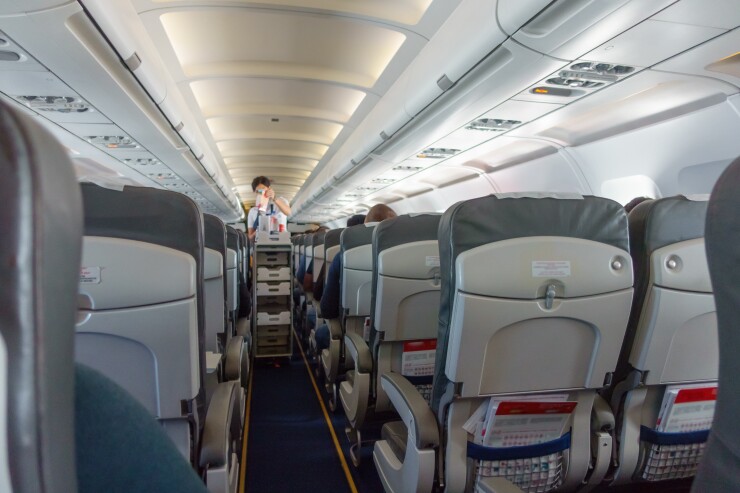The airline industry is challenged to meet new demands from passengers, most of whom don’t leave home without a mobile device. Customers are used to browsing and shopping when they want, however they want, and this expectation doesn’t stop because they’re not on solid ground.
Accommodating passengers’ demand to use their mobile devices in-flight can mean more than just improving your airline customers’ experience; it can also facilitate new and expanded revenue opportunities.
Mobility solutions designed specifically for airlines can make new, profitable options a reality. There are certain expectations that customers now have, and companies within the airline industry should take advantage of emerging technologies that can unlock new opportunities.

Currently, passengers are shelling out millions for early check-ins, seats with extra leg room, frequent-flier miles and in-flight purchases like meals, snacks, movies, Wi-Fi connectivity and retail items. According to the consulting firm
With the right in-flight mobility solution, an airline can enhance sales opportunities leveraging detailed customer information and product visuals. Flight attendants can access passenger data to identify high-value passengers like travel agents, and high-revenue and premium airline status customers.
Using travel and purchase histories, attendants can deliver a higher level of personalized service to increase sales and increase passenger loyalty and the likelihood the customer will make a repeat purchase or refer other customers.
The rise of self-service checkout lanes and kiosks in stores, restaurants and entertainment venues has given consumers more control over how, when and what they order. Instead of taking a passive role and waiting for a flight attendant to walk by with the drink or snack cart, people appreciate the ability to order via mobile device app or seatback screen. With an efficient in-flight system, an order appears as an alert on flight attendants’ mobile devices and the purchase can be delivered to the passenger’s seat. For added convenience, these systems could offer expanded shopping opportunities, allowing passengers to order items for in-flight delivery to business partners at the arrival gate or at home.
Passengers fill travel time in a variety of ways while in-flight, but many may appreciate the ability to use their flights to plan activities at their destinations, such as making dinner reservations or ordering tickets.
Before Wi-Fi connectivity was available in-flight, any planning for activities after landing were probably notes jotted on paper. With Wi-Fi, however, an airline can establish a gateway that provides a digital “concierge service” that offers products and discounts related to the flight’s destination.
While in-flight, passengers would be able to access a roster of area-related activity recommendations and booking options for entertainment venues, spas and restaurants, or rent a car or book a hotel. Leveraging partnerships, the airline can make exclusive offers such as VIP tickets to events at standard ticket prices, that are only made available to passengers who book in-flight. This provides the passenger with added value while opening a new revenue stream for the airline.
Most North American airlines don’t accept cash for in-flight purchases, even for lower-cost items like drinks or snacks. A mobile point of sale (mPOS) system enables flight attendants to quickly and efficiently accept credit cards while tracking inventory for faster replenishment once the aircraft lands. Wi-Fi connectivity can be spotty depending on the flight path, so an mPOS system that efficiently operates offline and syncs with the network when connectivity is restored is a must to offer seamless customer service.
No business likes to disappoint its customers. Enabling passengers to select an item from a list that’s updated in real time helps to manage their expectations and avoid the uncomfortable situation of having to report that what they want is out of stock.
Through screens or mobile apps, passengers can see the items, offers and retail products that are available and make their choices. This type of system enables ordering before the flight so passengers can ensure they always receive their first-choice of beverage, snack or meal.
As menu items, drinks or products are distributed, the point of sale solution dynamically updates the onboard inventory. This expedites restocking once a flight lands. In addition, an inventory management system enables airlines to collect data that helps to boost profits. For example, tracking sales of particular items will show top sellers on particular routes so inventory levels can be adjusted for higher sales. This data also helps ensure that the airline is stocking items that will sell and not just take up space.
This is a crucial offering, especially when it comes to flying food and drink to a cruising altitude, which can become a costly expense. The cost to provide that food and drink becomes all the more expensive when no-one buys it and it has to be thrown away.
Managing your stocks is not only about measuring sales — it’s also about knowing what isn’t selling, what is selling very fast and making sure you satisfy customer demand. You can keep passengers happy at the lowest possible provision cost by using technology to measure when an item ran out of stock, measure your wastage and adjust your stocks per flight to achieve the holy grail pairing of contented customers and empty carts.





